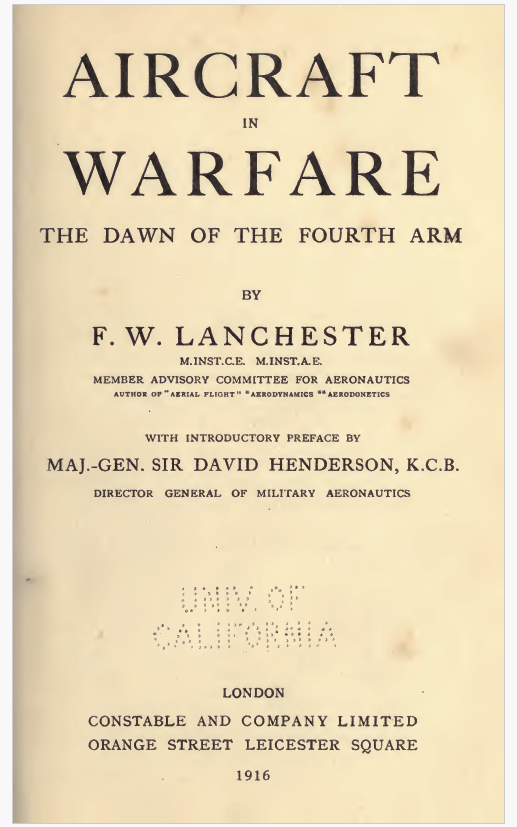Frederick Lanchester fue un personaje multifacético, la herencia de sus ecuaciones diferenciales y de los modelos de desgaste bélico han creado escuela. Pese a que existen muchas correcciones y debates sobre lo acertado de estos modelos, es necesario conocerlos someramente.

Como suelo hacer, os propongo un itinerario que comienza con una obra del autor, para luego tener disponibles unos cuantos documentos base que permitan posteriores investigaciones. Empecemos:
1. Aircraft in Warfare. The Dawn of The Fourth Army; 1916, London, Constable and company limited. Frederick Lanchester. (Enlace en la imagen).
2. Continuamos con estos tres volúmenes de la tetralogía De Physica Belli: An Introduction to Lanchestrial Attrition Mechanics, con ellos se adquieren las bases para comprender el tema de estudio. Como se indica en el abstract:
Physics and War are inextricable. While it is often recognized that war is often the generator of progress in physics, the role of physics in war is less often recognized. This work is dedicated to examination of the physics inherent in some of the processes of war. The framework for this examination is the Lanchester model of attrition. Part I of this work is primarily concerned with the basic foundation of this model. This volume, which comprises Part I, presents the mathematical and assumptive basis of homogeneous Lanchester theory, reviews the primary contributors – Lanchester, Chase, Osipov, and Fiske – to the basic theory, and the two basic alternative theories of the same genre. The historical basis for validity of Lanchester theory is reviewed and analyzed. The relationship between Lanchester theory and higher level simulation is introduced along with prefatory expositions of subsequent parts of the work. Part II (to be published) will cover the basic physics inherent in the attrition rate coefficients; Part III will cover heterogeneous Lanchester theory and aggregation; and Part IV will cover special and advanced topics.
3. Ahora ampliamos el campo con una batería de desarrollos y aplicaciones que sirvan de referencias para futuros estudios:
A comparison of some Lanchester models of the skirmish
Fractal Effects in Lanchester Models of Combat
A further comparison of deterministic and stochastic Lanchester-type combat models
A Lanchester-type analysis of the covering force commitment
A simplified model for the suppressive effects of small arms fire
Combat Analysis for Command, Control and Communications: A Primer 1993 Edition
Fitting firepower score models to the battle of Kursk data
EINSTein Goes to War: A Primer on Ground Combat Models
4. Y terminamos con otro clásico, Aggregation, Disaggregation, and the 3:1 Rule in Ground Combat de la RAND, criticado y discutido, pero que necesitaremos conocer si queremos criticarlo y discutirlo.

